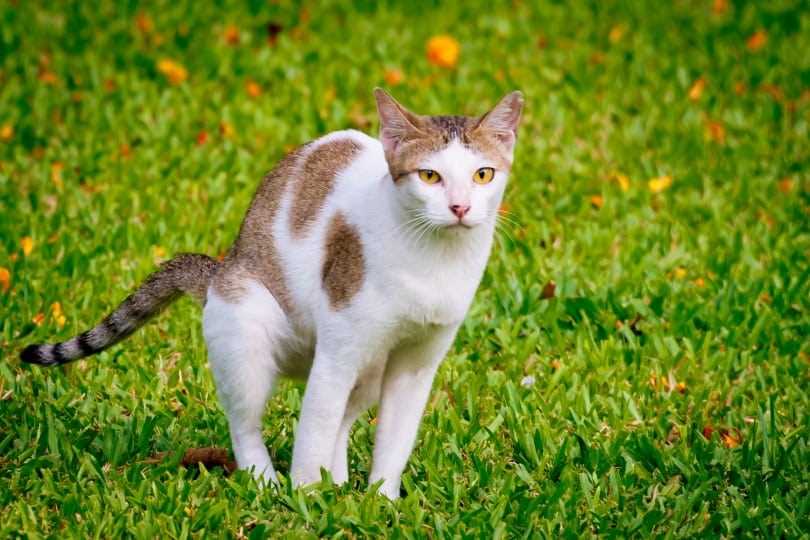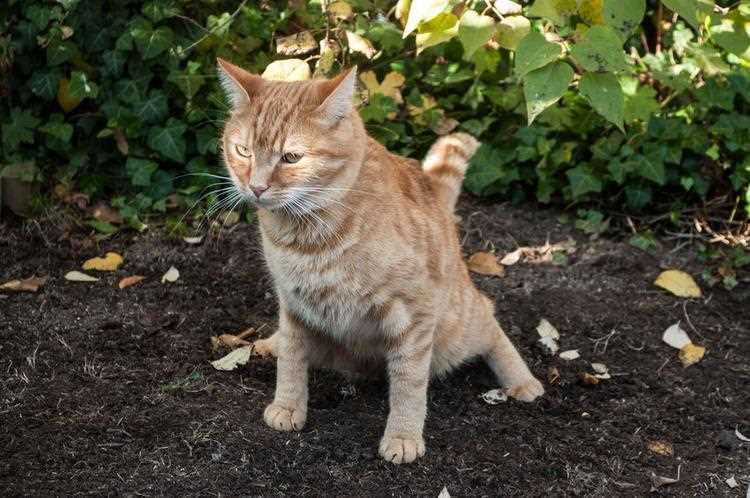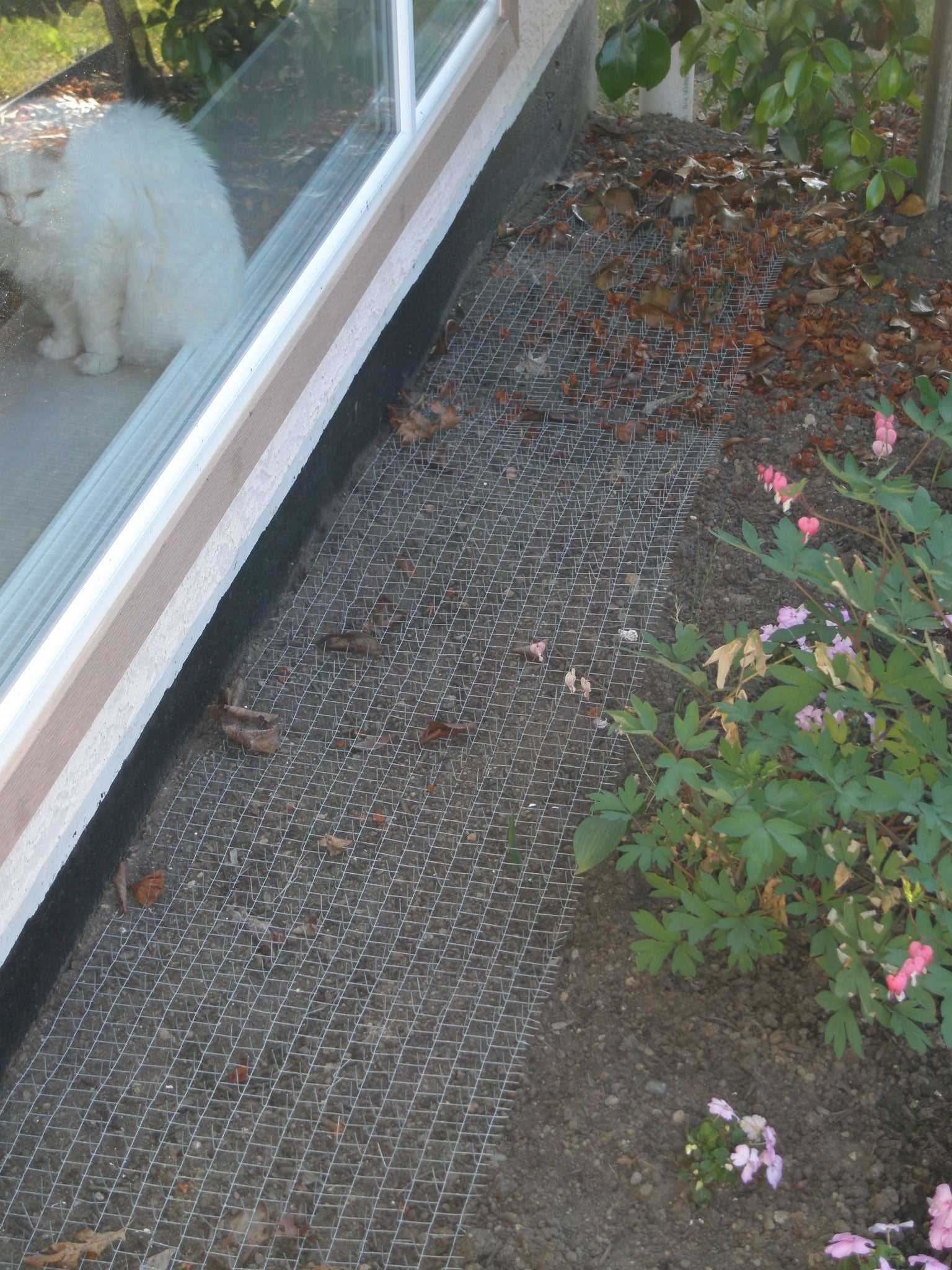To maintain a clean space, consider using citrus peels around the area. Cats generally dislike the smell of citrus, making it an excellent natural repellent. Placing orange or lemon peels strategically can deter them from exploring your territory.
Another approach involves installing motion-activated sprinklers. The sudden burst of water can startle any curious creature, encouraging them to look elsewhere for their bathroom needs. These devices are humane and provide a quick solution to keep furry intruders away.
Planting strong-smelling herbs like lavender, rosemary, or rue can also help. Cats tend to avoid areas with overpowering scents, which will make your garden less appealing to them. Incorporating these plants not only beautifies your space but also serves a practical purpose.
Lastly, consider creating barriers. A low fence or decorative rocks can act as physical deterrents. Cats prefer easy access, so making it slightly more challenging for them to enter can encourage them to find a different spot for their business.
Deterrents for Feline Behavior
Plant rosemary or lavender around the perimeter. The strong scents of these herbs repel many four-legged visitors.
Physical Barriers
- Install mesh fencing that is at least 3 feet high. Cats dislike climbing over tall, smooth surfaces.
- Use chicken wire or landscaping fabric on the ground. This makes the area uncomfortable for wandering paws.
Natural Repellents

- Citrus peels can deter intruders. Scatter orange or lemon rinds in the targeted areas.
- Vinegar spray is another option. Mix equal parts water and vinegar, then spray where needed.
Consider motion-activated sprinklers. A sudden burst of water can startle and send unwanted visitors running.
Using Natural Deterrents to Keep Felines Away
One effective method I’ve discovered is using citrus peels. I recommend placing orange or lemon rinds around areas that need protection. The strong scent is off-putting to many four-legged visitors.
Another option is to sprinkle coffee grounds in the targeted areas. The aroma deters curious noses, while also enriching the soil if left to decompose.
Herbal Solutions
Planting certain herbs, like lavender or rosemary, creates barriers that many prefer to avoid. These plants not only smell delightful to humans but also serve as natural repellents.
Homemade Sprays
Mixing water with vinegar or essential oils, such as citronella, can create a spray that helps maintain boundaries. Apply this mixture to the problem spots regularly for the best results.
Creating a Cat-Unfriendly Environment in Your Yard
Start by covering the ground with materials that are uncomfortable for furry visitors. Sharp stones, pine cones, or even rough mulch can deter them from choosing your space. A simple layer of chicken wire laid flat on the soil can be effective as well.
Incorporate motion-activated sprinklers. The sudden burst of water surprises intruders, encouraging them to find a more welcoming area. Additionally, citrus peels scattered around can serve as a natural repellent, as many felines dislike the scent of oranges and lemons.
Plant Deterrents

Consider planting certain herbs and flowers that naturally repel. Lavender, rosemary, and rue are known to keep furry friends at bay. Not only do they smell great to humans, but they can also create a barrier that many four-legged visitors will avoid.
Avoid using mulch made from cocoa shells, as it can be harmful to pets. Instead, explore alternative materials that provide both aesthetics and functionality without the risk. For instance, gravel or pebble beds can serve as beautiful, yet unfriendly, surfaces.
Other Effective Strategies
Installing a low fence or barrier can also help. Make sure it’s tall enough to prevent jumping. If you have garden beds, consider edging them with materials that are not comfortable to walk on, like prickly plants or thorny bushes.
Lastly, if you’re curious whether some foods interest furry visitors, you might want to check if will cats eat oatmeal. It’s useful to know what attracts them and adjust your strategies accordingly.
Training Techniques to Discourage Felines from Entering
Utilizing positive reinforcement is a highly effective method. Reward desired behaviors with treats or affection. For instance, when a neighborhood feline approaches the boundary of your space but turns away, offer a small treat to reinforce that choice.
Consistency is Key
Establish a routine with clear boundaries. Use visual cues like flags or small fences to mark off areas that should be avoided. This will help create an understanding of where they are welcome and where they are not.
Sound Deterrents

Incorporate sound devices that emit high-frequency noises when triggered. These sounds are generally unnoticeable to humans but can be unsettling for curious animals. Pair this with the previously mentioned training techniques for maximum impact.
For additional insights on feline health, check out what cat food dissolves urinary crystals.
FAQ:
What factors can keep cats from using my yard as a litter box?
Cats are creatures of habit and preference. They tend to avoid areas where they feel unsafe or uncomfortable. To deter cats from pooping in your yard, you might want to consider various factors. First, ensuring your yard is well-maintained can help. Cats are less likely to use areas that are regularly disturbed. Additionally, using certain scents can be effective; cats dislike citrus smells and certain herbs like lavender or rosemary. Physical barriers, such as fencing or planting thorny bushes, can also discourage cats from entering your space.
Are there specific plants that can deter cats from my garden?
Yes, several plants can act as natural repellents for cats. For instance, rue, lavender, and lemon balm are known to keep cats away due to their strong scents. Planting these around the perimeter of your yard can create a barrier that cats might find unappealing. Additionally, thorny plants like holly or barberry can serve as both a deterrent and a protective barrier for your garden. It’s also helpful to mix these plants with your existing garden to enhance the effect.
Is there a way to train my cat not to use the yard of others?
Training a cat to avoid certain areas requires patience and consistency. Start by creating a designated litter area in your home or yard that is appealing to your cat. Use positive reinforcement, such as treats or praise, when your cat uses the designated area. If your cat attempts to go in someone else’s yard, gently redirect them back to their spot. Over time, they may learn to associate their litter area with rewards, reducing the likelihood of wandering into other yards.
What are some humane methods to keep stray cats out of my yard?
To keep stray cats out of your yard humanely, consider using motion-activated sprinklers that spray water when a cat enters the area. Cats generally dislike getting wet and will avoid returning. You can also use cat-safe repellents that emit scents unpleasant to cats without harming them. Another method is to create physical barriers, such as fencing designed to keep cats out. Additionally, providing distractions like catnip or food in a different location may help lure them away from your yard.
To maintain a clean space, consider using citrus peels around the area. Cats generally dislike the smell of citrus, making it an excellent natural repellent. Placing orange or lemon peels strategically can deter them from exploring your territory.
Another approach involves installing motion-activated sprinklers. The sudden burst of water can startle any curious creature, encouraging them to look elsewhere for their bathroom needs. These devices are humane and provide a quick solution to keep furry intruders away.
Planting strong-smelling herbs like lavender, rosemary, or rue can also help. Cats tend to avoid areas with overpowering scents, which will make your garden less appealing to them. Incorporating these plants not only beautifies your space but also serves a practical purpose.
Lastly, consider creating barriers. A low fence or decorative rocks can act as physical deterrents. Cats prefer easy access, so making it slightly more challenging for them to enter can encourage them to find a different spot for their business.
Deterrents for Feline Behavior
Plant rosemary or lavender around the perimeter. The strong scents of these herbs repel many four-legged visitors.
Physical Barriers
- Install mesh fencing that is at least 3 feet high. Cats dislike climbing over tall, smooth surfaces.
- Use chicken wire or landscaping fabric on the ground. This makes the area uncomfortable for wandering paws.
Natural Repellents

- Citrus peels can deter intruders. Scatter orange or lemon rinds in the targeted areas.
- Vinegar spray is another option. Mix equal parts water and vinegar, then spray where needed.
Consider motion-activated sprinklers. A sudden burst of water can startle and send unwanted visitors running.
Using Natural Deterrents to Keep Felines Away
One effective method I’ve discovered is using citrus peels. I recommend placing orange or lemon rinds around areas that need protection. The strong scent is off-putting to many four-legged visitors.
Another option is to sprinkle coffee grounds in the targeted areas. The aroma deters curious noses, while also enriching the soil if left to decompose.
Herbal Solutions
Planting certain herbs, like lavender or rosemary, creates barriers that many prefer to avoid. These plants not only smell delightful to humans but also serve as natural repellents.
Homemade Sprays
Mixing water with vinegar or essential oils, such as citronella, can create a spray that helps maintain boundaries. Apply this mixture to the problem spots regularly for the best results.
Creating a Cat-Unfriendly Environment in Your Yard
Start by covering the ground with materials that are uncomfortable for furry visitors. Sharp stones, pine cones, or even rough mulch can deter them from choosing your space. A simple layer of chicken wire laid flat on the soil can be effective as well.
Incorporate motion-activated sprinklers. The sudden burst of water surprises intruders, encouraging them to find a more welcoming area. Additionally, citrus peels scattered around can serve as a natural repellent, as many felines dislike the scent of oranges and lemons.
Plant Deterrents

Consider planting certain herbs and flowers that naturally repel. Lavender, rosemary, and rue are known to keep furry friends at bay. Not only do they smell great to humans, but they can also create a barrier that many four-legged visitors will avoid.
Avoid using mulch made from cocoa shells, as it can be harmful to pets. Instead, explore alternative materials that provide both aesthetics and functionality without the risk. For instance, gravel or pebble beds can serve as beautiful, yet unfriendly, surfaces.
Other Effective Strategies
Installing a low fence or barrier can also help. Make sure it’s tall enough to prevent jumping. If you have garden beds, consider edging them with materials that are not comfortable to walk on, like prickly plants or thorny bushes.
Lastly, if you’re curious whether some foods interest furry visitors, you might want to check if will cats eat oatmeal. It’s useful to know what attracts them and adjust your strategies accordingly.
Training Techniques to Discourage Felines from Entering
Utilizing positive reinforcement is a highly effective method. Reward desired behaviors with treats or affection. For instance, when a neighborhood feline approaches the boundary of your space but turns away, offer a small treat to reinforce that choice.
Consistency is Key
Establish a routine with clear boundaries. Use visual cues like flags or small fences to mark off areas that should be avoided. This will help create an understanding of where they are welcome and where they are not.
Sound Deterrents

Incorporate sound devices that emit high-frequency noises when triggered. These sounds are generally unnoticeable to humans but can be unsettling for curious animals. Pair this with the previously mentioned training techniques for maximum impact.
For additional insights on feline health, check out what cat food dissolves urinary crystals.
FAQ:
What factors can keep cats from using my yard as a litter box?
Cats are creatures of habit and preference. They tend to avoid areas where they feel unsafe or uncomfortable. To deter cats from pooping in your yard, you might want to consider various factors. First, ensuring your yard is well-maintained can help. Cats are less likely to use areas that are regularly disturbed. Additionally, using certain scents can be effective; cats dislike citrus smells and certain herbs like lavender or rosemary. Physical barriers, such as fencing or planting thorny bushes, can also discourage cats from entering your space.
Are there specific plants that can deter cats from my garden?
Yes, several plants can act as natural repellents for cats. For instance, rue, lavender, and lemon balm are known to keep cats away due to their strong scents. Planting these around the perimeter of your yard can create a barrier that cats might find unappealing. Additionally, thorny plants like holly or barberry can serve as both a deterrent and a protective barrier for your garden. It’s also helpful to mix these plants with your existing garden to enhance the effect.
Is there a way to train my cat not to use the yard of others?
Training a cat to avoid certain areas requires patience and consistency. Start by creating a designated litter area in your home or yard that is appealing to your cat. Use positive reinforcement, such as treats or praise, when your cat uses the designated area. If your cat attempts to go in someone else’s yard, gently redirect them back to their spot. Over time, they may learn to associate their litter area with rewards, reducing the likelihood of wandering into other yards.
What are some humane methods to keep stray cats out of my yard?
To keep stray cats out of your yard humanely, consider using motion-activated sprinklers that spray water when a cat enters the area. Cats generally dislike getting wet and will avoid returning. You can also use cat-safe repellents that emit scents unpleasant to cats without harming them. Another method is to create physical barriers, such as fencing designed to keep cats out. Additionally, providing distractions like catnip or food in a different location may help lure them away from your yard.
To maintain a clean space, consider using citrus peels around the area. Cats generally dislike the smell of citrus, making it an excellent natural repellent. Placing orange or lemon peels strategically can deter them from exploring your territory.
Another approach involves installing motion-activated sprinklers. The sudden burst of water can startle any curious creature, encouraging them to look elsewhere for their bathroom needs. These devices are humane and provide a quick solution to keep furry intruders away.
Planting strong-smelling herbs like lavender, rosemary, or rue can also help. Cats tend to avoid areas with overpowering scents, which will make your garden less appealing to them. Incorporating these plants not only beautifies your space but also serves a practical purpose.
Lastly, consider creating barriers. A low fence or decorative rocks can act as physical deterrents. Cats prefer easy access, so making it slightly more challenging for them to enter can encourage them to find a different spot for their business.
Deterrents for Feline Behavior
Plant rosemary or lavender around the perimeter. The strong scents of these herbs repel many four-legged visitors.
Physical Barriers
- Install mesh fencing that is at least 3 feet high. Cats dislike climbing over tall, smooth surfaces.
- Use chicken wire or landscaping fabric on the ground. This makes the area uncomfortable for wandering paws.
Natural Repellents

- Citrus peels can deter intruders. Scatter orange or lemon rinds in the targeted areas.
- Vinegar spray is another option. Mix equal parts water and vinegar, then spray where needed.
Consider motion-activated sprinklers. A sudden burst of water can startle and send unwanted visitors running.
Using Natural Deterrents to Keep Felines Away
One effective method I’ve discovered is using citrus peels. I recommend placing orange or lemon rinds around areas that need protection. The strong scent is off-putting to many four-legged visitors.
Another option is to sprinkle coffee grounds in the targeted areas. The aroma deters curious noses, while also enriching the soil if left to decompose.
Herbal Solutions
Planting certain herbs, like lavender or rosemary, creates barriers that many prefer to avoid. These plants not only smell delightful to humans but also serve as natural repellents.
Homemade Sprays
Mixing water with vinegar or essential oils, such as citronella, can create a spray that helps maintain boundaries. Apply this mixture to the problem spots regularly for the best results.
Creating a Cat-Unfriendly Environment in Your Yard
Start by covering the ground with materials that are uncomfortable for furry visitors. Sharp stones, pine cones, or even rough mulch can deter them from choosing your space. A simple layer of chicken wire laid flat on the soil can be effective as well.
Incorporate motion-activated sprinklers. The sudden burst of water surprises intruders, encouraging them to find a more welcoming area. Additionally, citrus peels scattered around can serve as a natural repellent, as many felines dislike the scent of oranges and lemons.
Plant Deterrents

Consider planting certain herbs and flowers that naturally repel. Lavender, rosemary, and rue are known to keep furry friends at bay. Not only do they smell great to humans, but they can also create a barrier that many four-legged visitors will avoid.
Avoid using mulch made from cocoa shells, as it can be harmful to pets. Instead, explore alternative materials that provide both aesthetics and functionality without the risk. For instance, gravel or pebble beds can serve as beautiful, yet unfriendly, surfaces.
Other Effective Strategies
Installing a low fence or barrier can also help. Make sure it’s tall enough to prevent jumping. If you have garden beds, consider edging them with materials that are not comfortable to walk on, like prickly plants or thorny bushes.
Lastly, if you’re curious whether some foods interest furry visitors, you might want to check if will cats eat oatmeal. It’s useful to know what attracts them and adjust your strategies accordingly.
Training Techniques to Discourage Felines from Entering
Utilizing positive reinforcement is a highly effective method. Reward desired behaviors with treats or affection. For instance, when a neighborhood feline approaches the boundary of your space but turns away, offer a small treat to reinforce that choice.
Consistency is Key
Establish a routine with clear boundaries. Use visual cues like flags or small fences to mark off areas that should be avoided. This will help create an understanding of where they are welcome and where they are not.
Sound Deterrents

Incorporate sound devices that emit high-frequency noises when triggered. These sounds are generally unnoticeable to humans but can be unsettling for curious animals. Pair this with the previously mentioned training techniques for maximum impact.
For additional insights on feline health, check out what cat food dissolves urinary crystals.
FAQ:
What factors can keep cats from using my yard as a litter box?
Cats are creatures of habit and preference. They tend to avoid areas where they feel unsafe or uncomfortable. To deter cats from pooping in your yard, you might want to consider various factors. First, ensuring your yard is well-maintained can help. Cats are less likely to use areas that are regularly disturbed. Additionally, using certain scents can be effective; cats dislike citrus smells and certain herbs like lavender or rosemary. Physical barriers, such as fencing or planting thorny bushes, can also discourage cats from entering your space.
Are there specific plants that can deter cats from my garden?
Yes, several plants can act as natural repellents for cats. For instance, rue, lavender, and lemon balm are known to keep cats away due to their strong scents. Planting these around the perimeter of your yard can create a barrier that cats might find unappealing. Additionally, thorny plants like holly or barberry can serve as both a deterrent and a protective barrier for your garden. It’s also helpful to mix these plants with your existing garden to enhance the effect.
Is there a way to train my cat not to use the yard of others?
Training a cat to avoid certain areas requires patience and consistency. Start by creating a designated litter area in your home or yard that is appealing to your cat. Use positive reinforcement, such as treats or praise, when your cat uses the designated area. If your cat attempts to go in someone else’s yard, gently redirect them back to their spot. Over time, they may learn to associate their litter area with rewards, reducing the likelihood of wandering into other yards.
What are some humane methods to keep stray cats out of my yard?
To keep stray cats out of your yard humanely, consider using motion-activated sprinklers that spray water when a cat enters the area. Cats generally dislike getting wet and will avoid returning. You can also use cat-safe repellents that emit scents unpleasant to cats without harming them. Another method is to create physical barriers, such as fencing designed to keep cats out. Additionally, providing distractions like catnip or food in a different location may help lure them away from your yard.









